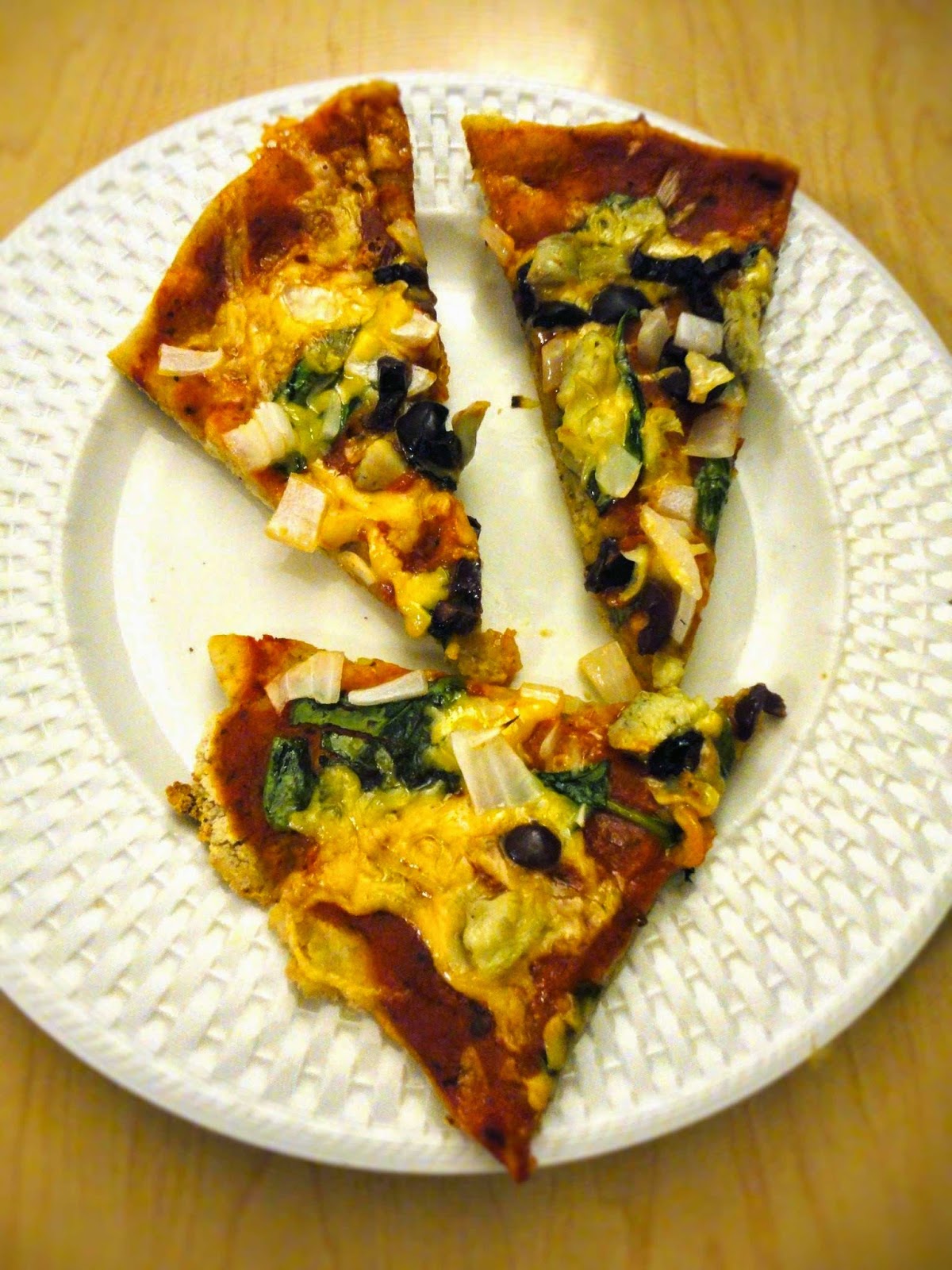
Ladies and gentlemen, I have done it.
After months of tweaking various recipes I've found all over the internet and trying pre-made mixes, I have settled on a pizza dough recipe that we both enjoy. I have made dozens of pizzas with this recipe. There are air pockets in the dough, it takes plenty of toppings without getting soggy, and is crispy on the bottom. It's good.
During this experience I have truly seen the light when it comes to baking by weight. Because two flours weigh differently (sometimes drastically different), using ½ cup of a 'similar' flour or starch interchangeably will result in a different end product. It can really screw things up – prevent your crust from browning, make the crumb too doughy, or cause too little moisture for a dry dough that is hard to work with.
This recipe is heavily based on the trial and error of both myself and others. I studied recipes, poured through books that explained the fundamentals of baking with gluten free flours and starches, and started with a dough recipe that was already highly rated by others in the gluten free world. Because Thomas and I are pretty picky about what we eat, I modified the recipe quite a bit to get it to our preferences. Feel free to do the same. Experiment until it tastes good. You'll still have pizza in the end, and pizza is good. Homemade pizza is ten times better.
Perfect Pizza
Serves 1 or (2)
Ingredients
For the crust:
15 g dry yeast
40 g melted vegan butter
1 3/4 Cups mildly hot water, around 110*F
120 g potato starch
120 g tapioca starch
120 g millet flour
120 g corn flour
dash salt
Optional crust add- ins: crushed red pepper, herbs, basil, sun-dried tomatoes
Pesto or tomato sauce
Toppings: spinach, artichoke, cheese, onion, mushroom, basil, tomato, pineapple, olives
Method
First... Prepare ingredients by melting butter over low heat, weighing out flours and starches into a large mixing bowl along with salt and crust add-ins, and preheating the oven to around 200*F.
Then... Mix 1 cup hot water into the melted butter, sprinkle yeast over the mixture, stir to remove any lumps, and set aside for 5 to 7 minutes.
Then... Pour the yeast mixture into the dry ingredients, stirring well to incorporate. Sprinkle the remaining water into the dough as needed to obtain the proper consistency.
***You want dough that holds together, but is slack like warm silly putty. You won't be able to make a ball that holds a smooth shape with it, but it's not watery and does not stick to your hands. The mixing bowl shouldn't have anything in it but some oil residue at this point.
Then... Let dough sit in middle of mixing bowl for one hour, draped with a towel, near the cracked oven door.
Then... After rising, increase the oven temperature to 425*F, remove the dough from the bowl and place it onto one sheet of parchment with another on top before rolling or patting flat. Slowly peel back the top layer of parchment in the opposite direction. Leave the crust on the bottom parchment paper and transfer this to a heavy baking sheet or a pizza pan.
Finally... Add toppings and bake for 10 minutes or until the edges begin to brown.
During the tweaking of this recipe I discovered several nuances about it. Too much sauce can keep the crust from crisping on the bottom, so roll it out a bit thicker than normal to keep the sauce from making the dough soggy. Using foil is a bad idea. You'll be picking foil chunks out of the underside of the pizza for several minutes before eating. However, if you don't have parchment, you can roll the dough on foil, just transfer it to a lightly floured pan. The flour might burn in the oven with the high heat, so keep the vent hood on if you have to do this. If we use a baking pan that is not heavy bottomed, the crust does not crisp as well.
Like I said before, I've made dozens of pizzas with this recipe. I've really made it mine and we are both happy with it every time I make it. We don't change the toppings much from one pizza to the next, but we do change the cheese and sauce which gives us just enough variety. Onions, spinach, artichoke hearts, basil, sun-dried tomatoes, olives, and cheese are our standbys.
Pizza was my last gluten meal. I had a Papa Johns on the way to the house when I found out I had Celiac. I cried, ate the pizza, and got over it. That day I really thought I was giving up all bread, beer, and pasta forever. It was the very first day for me and I had no clue that sorghum flour or millet flour existed, much less what sorghum or millet was to begin with. I've come so far since then. This January is four years gluten free and I've never felt better. The first couple of years of baking were difficult for me, but with patience and persistence I've really been able to conquer gluten free baking.
If your first pizza is a flop, don't give up! Just make notes, put the bad experience behind you, and keep tweaking and adjusting until you find what works for you. There are books and websites devoted to help you and guide you, take their advice and build on it.
- Patricia


